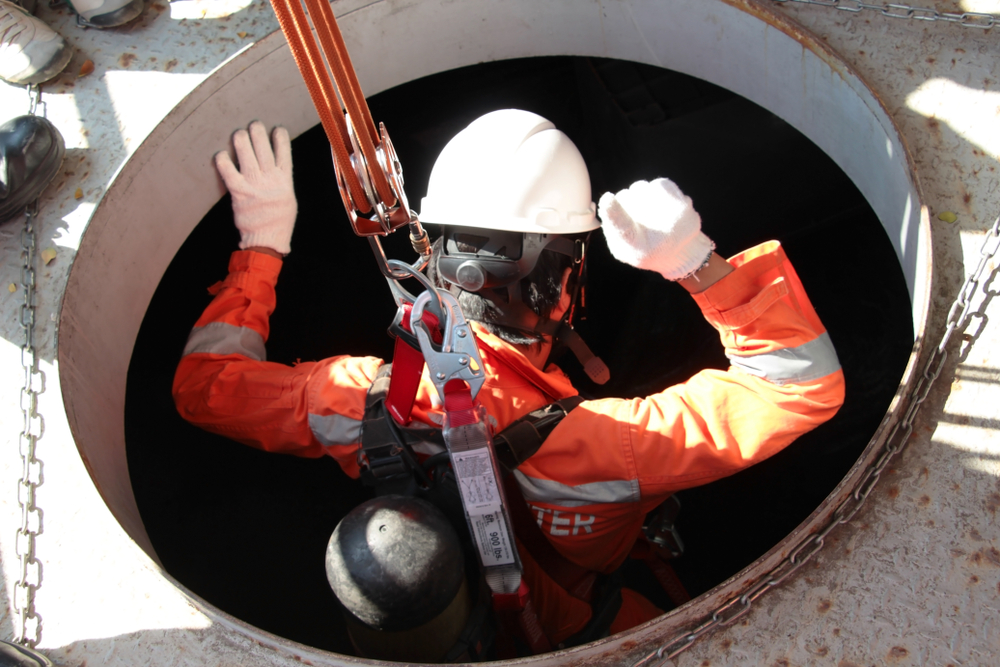Back to Basics is a weekly feature that highlights important but possibly overlooked information that any EHS professional should know. This week, we examine OSHA’s standards for confined spaces.
Confined spaces are defined by OSHA as spaces that are not necessarily designed for people, but are large enough that workers can go inside and perform specific tasks. They have limited or restricted means of entry and are not designed for continuous occupancy. Confined spaces create many hazards for employees in all different types of industries.
Definitions
Environments must meet certain criteria to be considered a confined space. By OSHA’s definition, confined spaces must be large enough for an employee to fully enter and perform assigned work, they cannot be designed for continuous occupancy by the employee, and they have a limited or restricted means of entry or exit. Confined spaces include underground vaults, tanks, storage bins, pits and diked areas, vessels, silos, manholes, tunnels, equipment housings, ductwork, pipelines, and other similar spaces.
Permit-required confined spaces contain or have the potential to contain a hazardous atmosphere, a material with the potential to engulf someone who enters the space, or any other recognized serious health or safety hazards. This kind of confined space may also have an internal configuration that might cause a worker to be trapped or asphyxiated by inwardly converging walls or a sloping floor.
Requirements
Employers must evaluate their workplaces to determine if there are permit-required confined spaces present. If there are, the employees who are exposed to them must be informed of their existence, location, and the hazards they pose. OSHA says this can be done by posting danger signs, with language such as “DANGER – REQUIRED CONFINED SPACE, DO NOT ENTER,” or similar wording that would satisfy the requirements for a sign.
If it is determined that employees need to enter permit spaces, the employer must develop and implement a written permit space program that shall be available for inspection by employees and their authorized representatives. If workers do not need to enter permit spaces, effective measures must be taken to prevent them from entering those spaces. Under certain specific conditions, employers can use alternate procedures for worker entry into a permit space.
OSHA’s standards require that an employer’s written permit space program implement the necessary measures to prevent unauthorized entry, and identify and evaluate permit space hazards before allowing employee entry. It must require testing of the atmospheric conditions in the permit space before entry operations, and monitoring during entry. Appropriate testing must be performed for atmospheric hazards in the order of oxygen, combustible gases or vapors, and toxic gases or vapors.
The program must also establish and implement the means, procedures, and practices to eliminate or control hazards necessary for safe permit space entry operations and identify employee job duties. Employers must provide and maintain personal protective equipment (PPE) and any other necessary gear for safe entry, at no cost to the employee, and require the workers to use it.
One attendant must be stationed outside the permit space during entry operations, and entry operations should be coordinated when employees of more than one employer are working in the same permit space. Appropriate procedures for summoning rescue and emergency services, and preventing unauthorized personnel from attempting rescue should be implemented.
Employers should establish, in writing, and implement a system for the preparation, issue, use, and cancellation of entry permits, and review established entry operations annually, revising the permit space entry program as necessary. Lastly, employers must implement procedures that any attendant who is required to monitor multiple spaces will follow during an emergency in one or more of those spaces.
Entry Permits
According to OSHA, a permit signed by the entry supervisor must be posted at all entrances to the confined space, or be made available to workers before they enter the permit space. The permit must verify that pre-entry preparations have been completed, and the duration of the entry permits must not exceed the time required to complete an assignment.
Entry permits must include the name of the permit space that is being entered, and the names of the authorized workers, eligible attendants, and individuals authorized to be entry supervisors. They must include test results, the tester’s initials or signature, and the name and signature of the supervisor who authorizes entry. The purpose of entry and known space hazards should be included, and the measures to be taken to isolate permit spaces and to eliminate or control space hazards.
OSHA outlines the remainder of what must be included on entry permits:
- Name and phone numbers of rescue and emergency services, and means of contacting them
- Date and authorized duration of entry
- Acceptable entry conditions
- Communication procedures and equipment
- Additional permits that authorize work in the space
- Special equipment and procedures, such as PPE and alarm systems
- Any other information needed to ensure employee safety
Entry supervisors must cancel entry permits when an assignment is completed or when new conditions exist, says OSHA. New conditions must be noted on the canceled permit and used in revising the permit space program. All canceled entry permits must be kept by employers for at least one year.
Training
OSHA requires employers to provide proper training to all workers who have to work in permit spaces before the initial work assignment starts, and ensure that after training, employees have acquired the knowledge and skills to safely perform their jobs. More training is required if the job duties change, if a change occurs in the permit space program or operations present any new hazards, or if an employee’s job performance is inadequate.
Rescue team members require training in CPR and first aid, and OSHA says employers must certify that this training was provided. After training is completed, employers must keep records of employee training and make it available for inspection by employees.
For more information, click here to view OSHA’s full standard for confined spaces.

